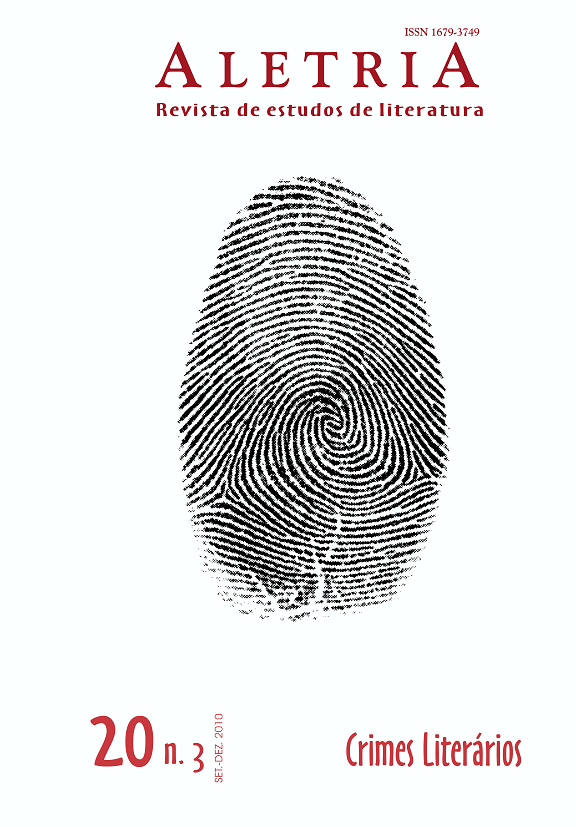Thomas de Quincey’s On Murder Considered as one of the Fine Arts or when Ethics Becomes a Matter of Taste
DOI:
https://doi.org/10.17851/2317-2096.20.3.193-209Keywords:
literature and murder, bare life, sublime, literature and realityAbstract
The text presents an analysis of Thomas De Quincey’s book On Murder Considered as one of the Fine Arts, published in 1827 in Blackwood’s Magazine. The interpretation is based on some concepts and ideas developed by Walter Benjamin (“critique of Gewalt [violence/power]”, “sacrifice” and “bare life”) and by Freud (Unheimlich, murder of the father of the primal horde). It discusses De Quincey’s publication in the context of a large tradition that dates back from Antiquity (tragedy theory) and goes up to the theory of the sublime. In this tradition, literature is considered a scene of a murder. De Quincey’s text is also seen as a forerunner of the detective novel and of New Journalism.
Downloads
References
ARISTÓTELES. La poétique. Org. e trad. Roselyne Dupont-Roc e Jean Lallot. Paris: Seuil, 1980.
BAUDELAIRE, C. O meu coração a nu. In: ______. Escritos íntimos. Trad. e prefácio Fernando Guerreiro. Lisboa: Editorial Estampa, 1982. p. 65-121.
BENJAMIN, Walter. Zur Kritik der Gewalt. In: ______. Gesammelte Schriften. Org. R. Tiedemann und H. Schweppenhäuser. Frankfurt a.M.: Suhrkamp. v. II: Aufsätze, Essays, Vorträge, 1974. p. 179-203.
BORGES, Jorge L. Ficcionario. Uma antología de sus textos. Ed. Emir R. Monegal. México: Fondo de Cultura Económica, 1985.
BURKE, Edmund. Uma investigação filosófica sobre a origem de nossas idéias do sublime e do belo. Trad. Enid A. Dobránsky. Campinas: Papirus/Unicamp, 1993.
BUSCH, Werner. Das sentimentalische Bild. Die Krise der Kunst im 18. Jahrhundert und die Geburt der Moderne. München: Beck, 1993.
DE QUINCEY, Thomas. On murder considered as one of the Fine Arts. Blackwood’s Magazine, Feb. 1827.
DE QUINCEY, Thomas. Do assassinato como uma das belas artes. Trad. Henrique de Araújo Mesquita. Porto Alegre: L&PM, 1985.
DE QUINCEY, Thomas. Confissões de um comedor de ópio. Trad. Ibañez Filho. Porto Alegre: L&PM, 2007.
FOUCAULT, Michel. Vigiar e punir. Trad. Raquel Ramalhete. Petrópolis: Vozes, 2009.
FREUD, S. Totem und Tabu. In: ______. Freud-Studienausgabe. Frankfurt/M.: Fischer Verlag, 1970. v. IX. p. 287-444.
FREUD, S. O mal-estar na cultura. Trad. Renato Zwick, revisão e introdução M. Seligmann-Silva. Porto Alegre: L&PM, 2010.
KANT, I. Über ein vermeintes Recht aus Menschenliebe zu lügen. In: ______. Werke, Darmstadt: Wissenschaftliche Buchgeselschaft, 1983. v. 7. p. 635-643.
LESSING, G.E. Laocoonte. Ou sobre as fronteiras da poesia e da pintura. Introdução, tradução e notas Márcio Seligmann-Silva. São Paulo: Iluminuras/Secretaria de Estado da Cultura, 1998.
MAUSS, Marcel. Ensaios sociológicos. Trad. L. Gaio e J. Guinsburg. São Paulo: Perspectiva, 1999.
MORITZ, Karl. Versuch einer deutschen Prosodie. In: ______. Werke. Org. Horst Günther. Frankfurt a. M., 1981. v. III. p. 472-577.
MORITZ, Karl. Über den Begriff des in sich selbst Vollendeten – An Herrn Moses Mendelssohn. In: ______. Werke. Org. Horst Günther. Frankfurt a. M, 1981. v. II. p. 543-549.
SANTO AGOSTINHO. Confissões. Trad. J. Oliveira Santos e A. Ambrósio de Pina. Petrópolis: Vozes, 1999.
SELIGMANN-SILVA, M. Ler o livro do mundo. Walter Benjamin: romantismo e crítica poética. São Paulo: Iluminuras/Fapesp, 1999.
SELIGMANN-SILVA, M. Walter Benjamin: o Estado de Exceção entre o político e o estético. In: ______ (Org.) Leituras de Walter Benjamin. S. Paulo: Fapesp/AnnaBlume, 2007. p. 213-238.
SIMON, Robert. I. Homens maus fazem o que homens bons sonham. Um psiquiatra forense ilumina o lado obscuro do comportamento humano. Trad. Laís Andrade e Rafael Torres. São Paulo: Artmed, 2009.
Downloads
Published
How to Cite
Issue
Section
License
Copyright (c) 2010 Márcio Seligmann-Silva (Autor)

This work is licensed under a Creative Commons Attribution 4.0 International License.
Authors who publish with this journal agree to the following terms:Authors retain copyright and grant the journal right of first publication with the work simultaneously licensed under a Creative Commons Attribution Non-Commercial No Derivatives License that allows others to share the work with an acknowledgement of the work's authorship and initial publication in this journal.Authors are able to enter into separate, additional contractual arrangements for the non-exclusive distribution of the journal's published version of the work (e.g., post it to an institutional repository or publish it in a book), with an acknowledgement of its initial publication in this journal.Authors are permitted and encouraged to post their work online (e.g., in institutional repositories or on their website) prior to and during the submission process, as it can lead to productive exchanges, as well as earlier and greater citation of published work (See The Effect of Open Access).





